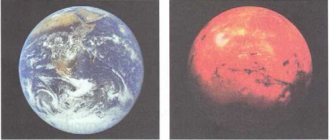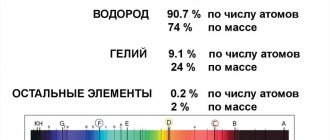A growing person is interested in literally everything. He asks questions about everything he sees. Why is the grass green? Why does the sun shine during the day and the stars at night? And so on and so forth. Answering seemingly simple questions is not always easy. Because sometimes some special knowledge is missing. And how can we explain something complex in a simple way? Not everyone can do this.
What is a star?
Without this concept, it is impossible to clearly explain why the sun shines during the day and the stars at night. Children often imagine stars as small dots in the sky, which they compare to small light bulbs or lanterns. If we draw an analogy, they can be compared to huge spotlights. Because stars are unimaginably huge balls of fire that are incredibly hot and are so far away from us that they seem like crumbs.
What is the sun?
First, you need to tell us that the Sun is a name, like a name. And the star closest to our planet bears this name. But why isn't it a point? And why does the sun shine during the day and the stars at night, if they are the same?
The sun does not appear to be a point because it is much closer than the others. Although it is also far from it. If you measure the distance in kilometers, the number will be equal to 150 million. A car will travel this distance in 200 years if it moves without stopping at a constant speed of 80 km/h. Due to its incredibly large distance, the sun appears small, although it is such that it could easily accommodate a million planets similar to Earth.
By the way, the sun is far from the largest and not very bright star in our sky. It is simply located in the same place as our planet, and the rest are scattered far in space.
How long will the sun burn?
The efficiency of the fusion reaction is the main reason the Sun constantly emits heat - the energy released by converting just one kilogram of hydrogen into helium is equivalent to that released by burning 20,000 tons of coal. Because the Sun is quite massive and relatively young, it is believed that it has only used about half of its fuel, hydrogen.
When the Sun exhausts all its hydrogen reserves (130 million years), it will switch to helium. After this, its luminosity will continue to increase until the Sun is 121% brighter and hotter than it is now. and it will enter the red giant phase.
Scientists believe that in 4–5 billion years the Sun will expand and engulf or heat up the Earth very much.
After the red giant, it will collapse and leave a compressed mass in an Earth-sized ball. This is the white dwarf stage. Eventually, the Sun's core will convert all of its hydrogen into helium and the star will die. This won't happen for about 5 billion years. The sun cannot just disappear or go out in an instant. The luminosity of our star increases by 1% every 110 million years due to the burning of hydrogen.
Video
Why is the sun visible during the day?
First you need to remember: when does the day begin? The answer is simple: when the sun begins to shine over the horizon. Without his light this is impossible. Therefore, answering the question of why the sun shines during the day, we can say that the day itself will not come if the sun does not rise. After all, as soon as it goes beyond the horizon, evening comes, and then night. By the way, it is worth mentioning that it is not the star that moves, but the planet. And the change from day to night occurs due to the fact that planet Earth rotates without stopping around its fixed axis.
Why are the stars not visible during the day if they, like the sun, always shine? This is explained by the presence of an atmosphere on our planet. In the air, the sun's rays scatter and outshine the faint glow of the stars. After it sets, the scattering stops, and nothing blocks their dim light.
The sun among different peoples in ancient times
In ancient times, people considered the Sun to be a deity and worshiped it. The heat and light that the luminary sent to Earth were perceived as gifts from above. The Slavs called the Sun God Yaril; they imagined him as a man with golden hair, who rushes across the sky every day riding a white horse.
The ancient Greek God of the Sun, Helios, also rides around his heavenly domains on horseback. His four snow-white horses are harnessed to a gilded chariot. Helios himself is a handsome, stately young man with long, flowing hair and a crown on his head.
The Egyptians represented the Sun in the form of a deity named Ra. It was a falcon, a large cat or a man, whose head was from a bird. The red disk of the Sun rose on it. People thought that during the day Ra sailed in a boat along the Nile River, illuminating the entire Earth with his light, and at night he transferred to another boat and sailed along the underground Nile, so the light was not visible.
Each people called the flaming ball the Sun differently and turned it into a living creature. The Romans have God Apollo, the Persians have Mithras, the Japanese have a girl - the goddess Amaterasu.
So what is the Sun?
All these were scientifically unsubstantiated arguments and legends. The concept of the sun from the point of view of science was first put forward by the Greek scientist and philosopher Anaxagoras. He argued that the Sun is a huge hot ball. His assumption was perceived as pseudoscientific and Anaxagoras was sent to prison.
The sun is truly a ball around which the Earth revolves. During the day, sunlight makes other objects in the sky invisible, including stars and the Moon. This happens because sunlight is much stronger and brighter than starlight. It outshines the glow of the stars as soon as morning comes. With the arrival of darkness, they reappear in the night sky.
Sun: star or planet?
The Sun is also a star, although there is a misconception that the Sun is a planet in the solar system. The temperature on the surface of the Sun is very high, such indicators are characteristic of stars, not planets. You can determine the temperature of a star by its color. If a star is blue, then it is very hot. Low temperatures are indicated by red. The Sun has an average temperature, which is why it is yellow. The mass of the fireball exceeds the size of all other planets. Nuclear reactions constantly occur on it, which are not seen on the planets of the solar system, but are possible only on stars. All these factors indicate that the Sun is a star. It is located closest to our planet than others.
It is the Sun, located at the center and the other planets that revolve around it, that constitute the solar system. In addition to planets, comets, asteroids and other cosmic bodies revolve around a hot star.
solar system
The planets of the Solar System are located in a certain sequence. The smallest and closest planet to the Sun is Mercury, the Earth is the third farthest from the luminous ball. Neptune and Pluto are located farthest from the fiery luminary.
Compared to it, planet Earth is very small. If you place many planets the size of Earth inside the Sun, you will get a million of them.
But the essence of the Sun is different. It is a source of heat and light for all living things on Earth. In addition, uniform rotation supports the existence of life. After all, if the Earth were constantly turned to the Sun with one side, then in the first half all living things would burn out. And the second half would freeze from low temperatures.
Reasons for the change of day and night
And even the change of day and night occurs thanks to this huge hot star. The earth rotates around its axis and makes a full circle in 24 hours.
The planet turns to the light, first one side, then the other. On the half illuminated by the sun's rays, the day lasts. That's why it's light during the day. On the opposite side, the night continues. The sun does not hit the earth, it is in the shadow, that is why it is dark at night.
Night and day are equal to each other only twice a year, on the days of the spring and autumn equinox. Interestingly, there are places where night on Earth is always equal to day. This happens at the equator.
Why is the moon visible at night?
So, the sun shines during the day and the stars at night. The reasons for this are in the air layer surrounding the earth. But why is the moon sometimes visible and sometimes not? And when it is there, it can take on different forms - from a thin sickle to a bright circle. What does this depend on?
It turns out that the moon itself does not glow. It works like a mirror that reflects the sun's rays onto the ground. And observers can see only that part of the satellite that is illuminated. If we consider the whole cycle, it begins with a very thin month, which resembles an inverted letter “C” or an arc from the letter “P”. Within a week it grows and becomes like half a circle. Over the next week it continues to increase and every day it gets closer to a full circle. Over the next two weeks, the pattern decreases. And at the end of the month, the moon completely disappears from the night sky. More precisely, it is simply not visible, because only that part of it that turned away from the Earth is illuminated.
What do people see in space?
Astronauts in orbit are not interested in the question of why the sun shines during the day and the stars at night. And this is due to the fact that both are visible there at the same time. This fact is explained by the absence of air, which prevents light from the stars from passing through the scattered rays of the sun. You can call them lucky because they can immediately see both the nearest star and those that are far away.
By the way, night lights differ in color. Moreover, this is clearly visible even from Earth. The main thing is to look closely. The hottest ones glow white and blue. Those stars that are cooler than the previous ones are yellow. These include our Sun. And the coldest ones emit red light.
What explains this?
So why does the Sun shine during the day and the stars at night? This phenomenon is explained directly by the location of the daylight hours. Our celestial body appears from behind the horizon in the morning, and in the evening it sets behind it, and the light disappears. This allows you to consider other subjects. This phenomenon is explained by the constant movement of our planet, which is difficult to notice.
Throughout the day, one side of the Earth’s ball is turned towards the Sun, while the second is located opposite, that is, turned away from it. Therefore, in fact, the time varies in different countries. That is, in one part of the world it is morning, while the other is just beginning to fall asleep.
Continuing the conversation about the stars
If the question of why the sun shines during the day and the stars at night arises among older children, then you can continue the conversation by remembering the constellations. They combine groups of stars that are located in one place on the celestial sphere. That is, they seem to be located nearby to us. In fact, there may be a huge distance between them. If we could fly far from the solar system, we would not recognize the starry sky. Because the outlines of the constellations would change greatly.
In these groups of stars, ancient people saw the outlines of human figures, objects and animals. In this regard, various names appeared. Ursa Major and Ursa Minor, Orion, Cygnus, Southern Cross and many others. Today there are 88 constellations. Many of them are associated with myths and legends.
Due to the rotation of the Earth around the Sun, the constellations change their position in the sky. And some are generally visible only in a certain season. There are constellations that cannot be seen in the Northern or Southern Hemisphere.
Over time, the constellations lost minor stars, and from their patterns it became difficult to guess how the name came about. The most famous constellation in the Northern Hemisphere, Ursa Major, has now turned into a “bucket”. And modern children are tormented by the question: “Where is the bear?”
History of the study of stars and their glow
Ancient Greek image of the starry sky
For a long period of time, astronomers could not come to a consensus regarding the nature of starlight. This question has given rise to numerous disputes over many centuries. These disputes were not only of a scientific nature - at the dawn of civilization, people built numerous myths, legends and religious conjectures explaining the presence of stars in the sky and their glow. In the same way, legends and everyday explanations were created for other astronomical phenomena observed in the sky - comets, eclipses, the movements of luminaries.
Interesting fact: some civilizations believed that the stars in the sky were the souls of the dead, others believed that these were the heads of nails with which the sky was nailed down. The Sun, on the other hand, was always considered separately; for thousands of years it was not classified as a star; it was too different in its appearance, observed from the surface of the Earth.
With the development of astronomy, the fallacy of such conclusions was revealed, and the stars began to be studied anew - like the Sun. Subsequently, it was possible to clarify that the Sun is also a star. Modern scientists classify the closest star to us as a red dwarf. However, the nature of the glow of the Sun and other stars gave rise to a lot of controversy until very recently.
Interesting: Why does a comet have a clear trajectory?











